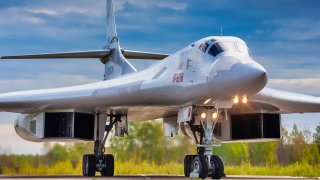How Russia Is Building the Nuclear Weapons of the Future
Threatening a nuclear war of annihilation is one of Moscow’s favorite sports.
In the next year or two when the Sarmat becomes operational, there will be an explosive increase in Russian strategic nuclear warhead potential. Irrespective of whether this is in 2024 or in 2025, the long-term effects will be the same. The frequent reports of 10-15 warheads for the Sarmat actually refer to the early concept for the missile which had half the launch weight of the 200-ton version that was actually developed. The 200-ton Sarmat makes no sense in the context of an arms control-limited force. The Russian Defense Ministry (MoD) said that the “…‘Sarmat’ will be able to carry up to 20 warheads of small, medium, high power classes.” The increase in the throw-weight from the 1979 vintage SS-18 Mod 4 to the Sarmat is consistent with the Russian MoD’s claim of 20 warheads for the Sarmat. Russian statements about their plans for the Sarmat range from 46 to 120 or more deployed launchers. In addition to normal ballistic warheads, the Sarmat can carry several Avangard hypersonic gliders and it has an orbital strike capability. The Commander of U.S. Strategic Command General Anthony Cotton confirmed its orbital capability even hinting it might go beyond a “partial” orbital capability. Multiple orbital capability facilitates surprise EMP attacks.
In the last few years, Russia has revealed the existence of several new ICBM programs beyond the Sarmat. Russia is continuing the old Soviet policy of starting a follow-on system once a new missile is deployed. Just announced is a follow-on for the Bulava-30 SLBM now being deployed on Borei-A submarines. Eventually there will likely be the improved Husky (Arktur) missile submarine with new nuclear ballistic and cruise missiles.
How many nuclear weapons does Russia have? The U.S. government has been silent on this issue since 2012. I have recently completed a National Institute for Public Policy paper on this subject. If one does a Google search on the number of Russia’s nuclear weapons one would be informed that Russia has 5,887 or 5,977 nuclear weapons. However, no one outside of the Russian Defense and Atomic Energy Ministries knows with confidence the exact number of Russian nuclear weapons. Everything else are estimates. There are a number of higher estimates, but they are usually completely ignored in almost all press commentary.
The 5,889 (2023) and the 5,977 (2022) numbers come from the Federation of American Scientists (FAS), a left-of-center Washington think tank that does not support U.S. nuclear modernization or the nuclear Triad. The FAS supports what it calls “minimal deterrence” which is defined as: 1) reducing the number of U.S. nuclear warheads to 500, 2) reducing the yield of U.S. nuclear warheads to 3-10 kilotons, 3) eliminating all U.S. counterforce capability, and 4) eliminating the entire U.S. ballistic missile submarine force. The FAS numbers are almost completely undocumented. I believe that for nearly all of the FAS numbers there are no available sources that support them. They are at the low end of existing estimates. In particular, Russian estimates are frequently much higher. For example, in 2021, Pavel Felgenhauer wrote, “Indeed, taking into account non-strategic (tactical) nuclear weapons, which no one has ever verifiably counted, Russia may have more (maybe twice as many overall) than all the other official or unofficial nuclear powers taken together.”
In December 2017, Bill Gertz reported, “Russia is aggressively building up its nuclear forces and is expected to deploy a total force of 8,000 warheads by 2026 along with modernizing deep underground bunkers, according to Pentagon officials. The 8,000 warheads will include both large strategic warheads and thousands of new low-yield and very low-yield warheads to circumvent arms treaty limits and support Moscow’s new doctrine of using nuclear arms early in any conflict.” In August 2019, then-Deputy Assistant Secretary of Defense for Nuclear Matters Rear Admiral (ret.) Peter Fanta confirmed the Gertz story stating that, “The Russians are going to 8,000 plus warheads.” In an analysis published in September 2019, James R. Howe, Vice President of Vision Centric, said that the planned Russian strategic nuclear force could carry between “2,976 WHs [warheads], and a maximum of 6,670 WHs” plus over 800 bomber weapons.
All of these estimates predate the end of New START Treaty on-site inspections in March 2020. The New START Treaty verification regime is very poor. It is critically dependent on Treaty on-site inspections. Given Russian violations of the New START Treaty, its illegal “suspension” in 2022 of the Treaty and the end of New START Treaty data notifications, the upload of most or even all of Russian strategic nuclear forces could have happened. None of this is taken into account in the existing estimates of the size of the Russian strategic nuclear forces. The Biden Administration’s conclusion that that, “Russia did not engage in significant activity above the Treaty limits in 2022” is little more than wishful thinking.
In light of Russia’s attitude toward nuclear weapons, it has every incentive to exploit the opportunity provided by the lack of on-site inspections and its suspension of the New START Treaty.
Even prior to these developments there were many reports of Russian violations of the New START Treaty. These violations involved the deployment of long-range nuclear cruise missiles on fighters and Backfire bombers and repeated statements by Colonel General Karakayev that Russia had more ICBMs than it could possibly have if it was in compliance with the New START Treaty. Since Russia was almost at the New START Treaty limit of 1,550 deployed warheads (it declared 1,549 accountable warheads in September 2022) several times as many missiles than the 31 deployed in 2023 would have to have been downloaded to stay within New START Treaty limits. There is unlikely to be any evidence of this absent on-site treaty inspections.
Colonel General Karakayev’s statement that mobile Yars ICBMs were deployed with less warheads than the silo based Yars is very interesting. Such warhead allocation enhances strategic counterforce capability under New START Treaty limitations. This is the opposite of what a nation would do if it is worried about the survivability of its strategic forces. However, it has the effect of allowing rapid and covert upload and download of its ICBMs which otherwise would likely take much longer for its SLBMs and bombers.
The Biden Administration is maintaining the illusion that U.S. national security can be advanced by a new nuclear arms control agreement with Russia. The latest Biden Administration nuclear arms control proposal was rejected almost immediately by the Putin regime. As the recent report of the United States Strategic Posture Commission recognized: 1) “…there is no prospect of a meaningful arms control Treaty being negotiated with Russia in the foreseeable future…”; 2) “Over the past 20 years, Russia has either violated or has failed to comply with nearly every major arms control treaty or agreement to which the United States is or was a party.”; and 3) “…given Russia’s history of noncompliance and illegal treaty suspensions, and China’s continued intransigence on arms control dialogue, the United States cannot develop its strategic posture based on the assumption that arms control agreements are imminent or will always be in force.”
Russia’s arsenal of non-strategic or tactical nuclear weapons is vastly larger than that of the United States and includes the full scope of Soviet-era tactical nuclear capabilities. The usual estimate of 2,000 Russian vs. 200 for the United States probably dramatically understates the scope of the Russian advantage. The Russian claim of a 75% reduction since the end of the Cold War results in the retention of 5,000 tactical nuclear weapons or about 25 times the reported U.S. number. There are even higher estimates of the Russian arsenal. Russia is in the process of creating a non-strategic hypersonic nuclear missile Triad.
In December 2023, President Putin declared that his war against Ukraine would ensure Russia’s “global sovereignty.” Putin has a record of making expansive statements about the meaning of Russian sovereignty, but this formulation is apparently unprecedented and particularly ominous.
In paragraph 4 of Putin’s decree on nuclear deterrence, Russian sovereignty is linked to nuclear weapons use. Putin now denies any intent to attack NATO. Yet the Putin regime said the same thing for months prior to its brutal 2022 invasion of Ukraine. Indeed, his Foreign Minister Sergei Lavrov even denies that the Russian invasion of Ukraine is an “invasion.” It is still possible that Russia will use nuclear weapons against Ukraine. The United States and NATO are doing almost nothing to deter nuclear escalation.
About the Author
Dr. Mark B. Schneider is a Senior Analyst with the National Institute for Public Policy. Before his retirement from the Department of Defense Senior Executive Service, Dr. Schneider served as Principal Director for Forces Policy, Principal Director for Strategic Defense, Space and Verification Policy, Director for Strategic Arms Control Policy and Representative of the Secretary of Defense to the Nuclear Arms Control Implementation Commission. He also served in the senior Foreign Service as a Member of the State Department Policy Planning Staff.


